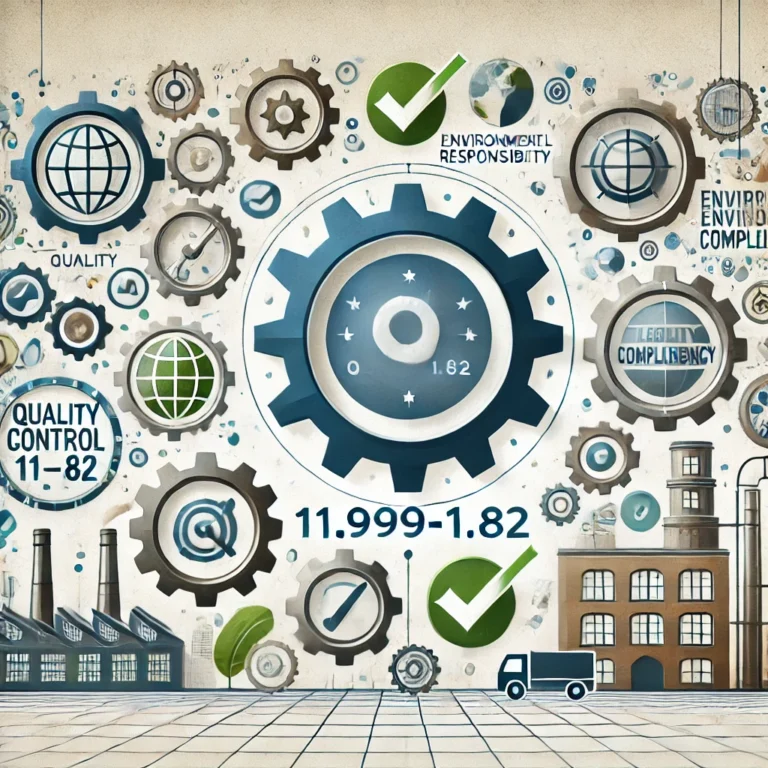In today’s rapidly advancing world, staying updated with industry standards and regulations is critical. For those in industries requiring precision, the 11.999-1.82 standard serves as a crucial benchmark for quality and compliance. This article explores the nuances of this standard, detailing its importance, applications, and how companies can effectively implement it to ensure compliance and excellence.
What is the 11.999-1.82 Standard?
The 11.999-1.82 standard is an established framework designed to set clear, quantifiable requirements for specific processes and materials across various sectors. This standard addresses aspects of safety, quality, efficiency, and environmental impact, helping industries maintain reliable production methods while upholding legal and ethical responsibilities.
The Core Objectives of the 11.999-1.82 Standard
- Quality Control: The standard mandates stringent quality checks and consistent monitoring throughout the production lifecycle, ensuring that products meet established criteria.
- Efficiency Improvement: By following the standard, companies streamline processes, which reduces waste, optimizes resource use, and improves productivity.
- Environmental Responsibility: This standard promotes practices that reduce environmental harm, ensuring that companies work within ecological parameters.
- Legal Compliance: Adhering to the 11.999-1.82 standard often aligns businesses with local, national, and international regulations, reducing the risk of penalties and legal disputes.
Why is 11.999-1.82 Important Across Industries?
The 11.999-1.82 standard holds immense value for various industries as it provides a common ground for quality and consistency. By implementing this standard, companies demonstrate their commitment to excellence, which builds customer trust and improves brand reputation.
Applications of 11.999-1.82 in Different Sectors
- Manufacturing: Ensures that all products meet minimum quality requirements, minimizing defective outputs and enhancing the safety and durability of products.
- Construction: Promotes safety in building materials and techniques, ensuring durability and stability in structures.
- Pharmaceuticals: Sets stringent safety and quality parameters for drug production, enhancing patient safety and compliance with regulatory bodies.
- Automotive: Improves vehicle safety standards, addressing issues such as emissions, safety features, and quality control.
Key Components of 11.999-1.82 Compliance
1. Documented Procedures
A significant aspect of the 11.999-1.82 standard is maintaining detailed documentation for every step in the production process. These documents should include process outlines, safety checks, environmental assessments, and any corrective actions taken. Documentation ensures traceability and accountability, making it easier to identify and rectify any deviations from the standard.
2. Quality Testing and Monitoring
Regular quality testing and monitoring are essential for companies adhering to the 11.999-1.82 standard. Tests should be designed to check product durability, safety, and efficiency. Testing frequencies should be based on the product’s nature, but regular audits are essential to meet compliance and quality expectations consistently.
3. Training and Workforce Development
Implementing this standard requires skilled and trained personnel. Employee training should include courses on the importance of the 11.999-1.82 standard, safety practices, environmental stewardship, and regulatory compliance. With knowledgeable staff, companies can seamlessly align operations with the standard’s requirements.
4. Continuous Improvement Processes
The 11.999-1.82 standard is not static; it is designed to promote continuous improvement. Regular assessments, feedback loops, and corrective action plans are necessary to keep up with evolving industry requirements and technological advancements. Continuous improvement ensures that companies remain competitive and compliant in the long term.
Benefits of Adopting the 11.999-1.82 Standard
- Improved Product Quality: The standard’s focus on quality controls means that products are more likely to meet customer expectations and regulatory standards.
- Enhanced Efficiency: Streamlined processes reduce costs, minimize waste, and shorten production timelines, positively impacting the bottom line.
- Strengthened Customer Confidence: Customers tend to trust businesses that adhere to recognized standards, enhancing customer loyalty and satisfaction.
- Better Environmental Stewardship: Compliance often aligns with eco-friendly practices, which helps companies reduce their environmental impact.
- Competitive Advantage: Adopting the standard sets businesses apart from competitors that may not meet such rigorous guidelines.
Challenges in Implementing the 11.999-1.82 Standard
While beneficial, implementing this standard comes with challenges that companies must overcome:
- High Initial Costs: Investing in technology, staff training, and process adjustments can be costly at first.
- Need for Specialized Skills: To ensure full compliance, companies may need to hire or train specialists in quality assurance, environmental safety, and legal compliance.
- Documentation and Administrative Load: Keeping up with extensive documentation can be time-consuming and may require dedicated resources.
Best Practices for Successful 11.999-1.82 Compliance
1. Conduct a Thorough Gap Analysis
A gap analysis helps businesses identify areas where they fall short of the standard’s requirements. This step enables companies to target specific processes or aspects that require improvement, making it easier to create actionable plans for compliance.
2. Invest in Technology and Automation
Automation can streamline compliance efforts by enhancing accuracy and reducing human error. For instance, automated quality checks and reporting systems can track compliance metrics in real-time, providing alerts when deviations occur.
3. Establish a Dedicated Compliance Team
A dedicated compliance team is invaluable for ongoing adherence to the 11.999-1.82 standard. This team should oversee audits, document updates, training sessions, and continual improvement initiatives, ensuring all departments remain aligned with the standard’s requirements.
4. Regular Audits and Reviews
Frequent audits are essential for tracking compliance with the standard. Audits should involve checks on product quality, documentation accuracy, employee adherence, and safety protocols. Regular reviews help companies identify trends, rectify issues, and ensure that processes evolve alongside industry changes.
The Future of the 11.999-1.82 Standard
As industries continue to evolve, so too will the 11.999-1.82 standard. Advances in technology, shifts in environmental policies, and new safety regulations are expected to impact this standard. Companies that proactively adapt to these changes by revisiting and refining their processes will not only stay compliant but also position themselves as leaders in their fields.
Conclusion
The 11.999-1.82 standard serves as a critical guideline for businesses across multiple sectors. By promoting quality, safety, efficiency, and environmental responsibility, this standard provides a framework that drives continuous improvement. While implementing this standard may present challenges, the benefits in terms of improved quality, customer confidence, and competitive advantage make it a valuable investment for any business committed to excellence.




